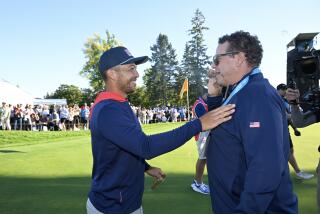This Cup Isn’t Overflowing With Tradition
- Share via
Everybody knows what the Presidents Cup is. It’s that sailing trophy. No, it’s what you find beside the coffee maker in the White House kitchen. No, it’s first cousin to the Stanley Cup.
Of course, the Presidents Cup is none of those things. It’s a biennial match-play golf competition between U.S. players and players from everywhere else but Europe.
Simple enough. If that sounds sort of like the Ryder Cup -- a biennial match-play golf competition between U.S. players and players from nowhere else but Europe -- you have achieved the desired distinction.
The only difference, really, is that the Ryder Cup has been around since 1927 and the Presidents Cup has been around since last week.
It just seems that way when you compare it to the Ryder Cup, but the Presidents Cup arrived in 1994 and the fifth version will be played in November in South Africa.
The main reason it’s being played at all is through the persistence of PGA Tour Commissioner Tim Finchem, who must have noticed that the four majors and the Ryder Cup are the most important events in golf and he had nothing to do with any of them.
What he came up with was an imitation Ryder Cup. Is that bad? When we check the ratings in a couple of months, we’ll know at least part of the answer.
Postponed a year (along with the Ryder Cup) because of the tragic events of Sept. 11, 2001, the Presidents Cup seems to have arrived at a turning point in its short and so far modestly successful history.
In the last Presidents Cup, the U.S. team scored a lopsided 21 1/2-10 1/2 victory at the Robert Trent Jones Golf Club in Virginia, but it should be noted that with this year’s event in South Africa, the only other time it was held outside the U.S., the International team scored an equally lopsided victory.
That was in 1998 at Royal Melbourne Golf Club on a mid-December date that didn’t sit well with a somewhat uninterested U.S. team, which lost, 20 1/2-11 1/2, in a competition that was all but over after the second day with the International team leading by nine points.
The fast facts are that U.S. has won three of the first four Presidents Cup matches and that this is not the Ryder Cup.
Maybe that identity issue is not going to make any difference in a few years after the Presidents Cup matures. But it’s never good when one of the main story lines leading up to the competition is whether the players who are eligible intend to show up. This does not happen at the Ryder Cup.
Maybe that’s why it’s interesting to note that player resolve did not become a measure of distraction and that everyone who qualified is showing up at Fancourt Hotel and Country Club in George, South Africa.
This means Tiger Woods and Phil Mickelson and Davis Love III and the rest are all matching the commitment of Ernie Els and Vijay Singh and Mike Weir.
It’s also a good sign that such players as Bob Estes and Fred Funk, who were on the bubble with enough points to qualify, went out of their way to promote themselves for the team.
At the very least, the players need to care about playing. That’s a good place to start. We should hold judgment until we see if anyone has an untimely injury and must stay at home as November nears.
As far as influence peddling goes, it’s possible that was a factor in getting the players involved. After all, few can twist arms the way Jack Nicklaus, the U.S. captain, can. Plus, Finchem expects his stars to show up, because he has been more responsible than anyone for pushing this concept onto golf’s center stage.
It’s also no accident that the event is being played at a course designed by Gary Player, who just happens to be the International team captain and is, of course, from South Africa.
But in the end, the Presidents Cup will be judged by the quality of the performances by the players, the level of their interest and whether there is a market for another international match-play competition -- scheduled the week before Thanksgiving -- according to the television ratings.
In 2005, the Presidents Cup returns to Virginia, where it will start another chapter. It’s possible that the powers behind the event know that they can’t summon the power of history to the Presidents Cup and give it more weight than it has earned.
There’s another part of the history debate. It’s also possible that the best way to get history on your side is to make a little of it. And hope somebody cares.
More to Read
Go beyond the scoreboard
Get the latest on L.A.'s teams in the daily Sports Report newsletter.
You may occasionally receive promotional content from the Los Angeles Times.










